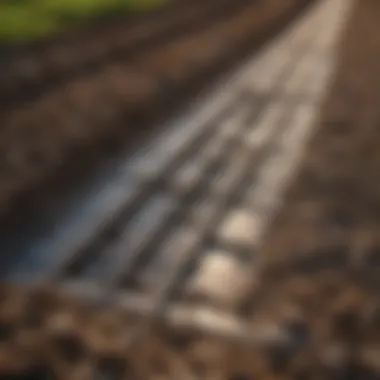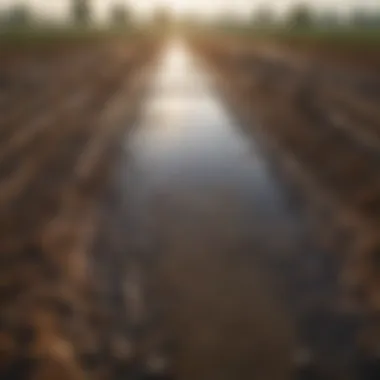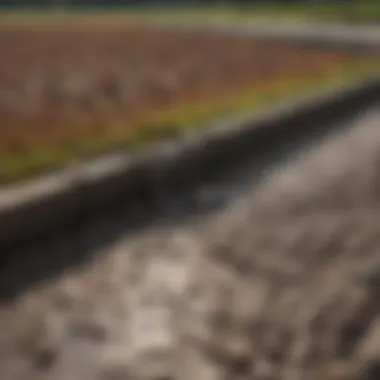Cost Considerations for Installing Drain Tile in Agriculture


Overview of the Topic
Installing drain tile is essential in agricultural management. It helps control excess water in fields that might otherwise lead to poor crop yields and soil erosion. Understanding the financial implications of such an installation is critical for farmers.
Definition and Importance
Drain tile is a type of drainage system consisting of perforated pipes laid underground to redirect water away from fields. This method not only prevents waterlogged conditions but also improves soil quality. Farmers recognize its significance when faced with issues like flooding, maintaining productivity while preserving arable land.
Current Trends
Recently, many agricultural areas adopt advanced drainage technologies. These technologies may include improved materials or novel installation techniques. As the industry evolves, farmers increasingly seek sustainable ways to manage their water resources effectively.
Key Techniques and Practices
Step-by-Step Guide
- Site Assessment: Evaluate the land to determine drainage needs, considering soil type and topography.
- Design Planning: Create a layout for the drain tile system based on the site assessment.
- Material Selection: Choose appropriate drain tile materials; for example, PVC or corrugated plastic tiles are common choices.
- Installation: Ensure proper installation depth and spacing is maintained. Use an excavation machine to create trenches.
- Testing: After installation, perform a functionality test to ensure the system works correctly.
- Maintenance Schedule: Create a routine for checking and clearing blockages.
Tools and Equipment Needed
To efficiently install drain tile, several tools are essential. These include:
- Excavator: For digging trenches.
- Laser Level: To ensure correct slope and alignment of tiles.
- Trenching Machine: For quicker installation of pipes.
- Shovels and Rakes: For manual adjustments during setup.
- Connection Materials: Such as couplers and sealants.
Challenges and Solutions
Common Obstacles
Farmers may encounter certain challenges while implementing drain tile systems. Common obstacles include:
- High Installation Costs: Initial capital outlay can be significant.
- Soil Conditions: Rocky or heavily compacted soil may complicate installation.
- Water Table Variability: Changes in groundwater levels affect drainage efficiency.
Innovative Solutions
Various strategies can address these challenges. For instance:
- Cost-sharing Programs: Look for local or national programs that provide financial assistance for drainage projects.
- Utilizing Technology: Employ drones or GIS technology for efficient site assessments.
- Regular Monitoring: Implement sensors to monitor soil moisture levels, aiding in better decision-making.
Effective management of drainage systems can lead to substantial long-term savings and improved crop yields.
In upcoming sections, the article will explore budgeting strategies and maintenance considerations. Understanding all these dimensions will provide farmers with valuable insights into their drain tile investments.
Foreword to Drain Tile
Drain tile is a crucial component of effective agricultural practices. Proper drainage management can serve as a decisive factor in sustainable farming. When fields retain excess water, plant growth can be stunted, affecting yields and ultimately lead to economic loss. Understanding drain tile provides farmers and agricultural professionals with insight into an essential tool that helps in land productivity.
Definition of Drain Tile
Drain tile refers to a system of underground piping designed to redirect excess water from the surface. These pipes are typically installed in trenches and perforated to facilitate the flow of water into them. The configuration varies, but the primary objective remains the same: to move water away from crop roots and prevent waterlogging, which can harm plant health and soil structure. The materials used include plastic, clay, or concrete, with each material presenting its own advantages and considerations for cost and lifespan.
Importance in Agriculture
The importance of drain tile in agriculture cannot be overstated. A well-designed drainage system can transform unusable land into productive fields. Efficient drainage minimizes waterlogging and promotes better aeration of the soil. This leads to several benefits, including:
- Improved Crop Health: Adequate drainage allows for healthy root development by avoiding water-related diseases.
- Increased Yields: Fields that are properly drained typically show higher crop productivity because the crops can access nutrients and water more effectively.
- Soil Protection: Drain tile reduces soil erosion by controlling surface water runoff. This helps preserve topsoil, which is vital for sustainable agricultural practices.


"Effective drain tile installations can lead to healthier crops, better yields, and more sustainable farming practices."
In summary, understanding drain tile is essential for any farmer aiming to enhance their agricultural operations. The ability to manage water effectively not only impacts crop yield but also contributes to long-term sustainability.
Factors Influencing Installation Costs
The cost of installing drain tile is not a one-size-fits-all matter. Various factors can significantly alter the overall expenses associated with the project. Understanding these factors is essential for effective budgeting. This section will explore the core components that dictate installation costs, specifically focusing on material costs, labor costs, and site characteristics.
Material Costs
Types of Drain Tile
Types of drain tile play a major role in determining material costs. Common types include plastic, ceramic, and concrete tiles. Each type has its own unique properties and potential applications.
Plastic drain tiles, often made from corrugated polyethylene, are lightweight and resistant to corrosion. They are usually the most cost-effective choice. This type of drain tile commonly finds use in various agricultural applications due to its durability.
Ceramic tiles, while more aesthetically pleasing, typically come with a higher price tag. They can be more fragile than their plastic counterparts, making their installation more costly.
Concrete tiles offer another option, known for their strength. However, they are more challenging to install and transport due to their weight. In terms of overall effectiveness, plastic tends to be the most popular choice for farmers due to its ease of installation and reasonable cost.
Comparative Material Prices
Comparative material prices often reveal the financial landscape for farmers. Prices can vary widely based on factors like geographic location and market demand. A comparison of costs between plastic, ceramic, and concrete tiles can help farmers make informed decisions.
For instance, while the upfront costs of ceramic or concrete tiles may seem appealing due to their longevity, farmers must consider the initial investment required. On the other hand, plastic tiles may require less upfront cash while still providing adequate longevity.
A thorough analysis of material pricing can help in understanding the trade-offs. Hence, this aspect is critical in effective cost planning for installing drain tile.
Labor Costs
Skilled vs. Unskilled Labor
The distinction between skilled and unskilled labor can have substantial implications on overall project costs. Skilled laborers, such as those with experience in installing drain tile, may command higher wages. However, their expertise can lead to a more efficient installation process.
On the contrary, unskilled laborers usually come at a lower cost but may not perform the tasks as efficiently or correctly. This can lead to additional expenses later on, eliminating any perceived savings. Therefore, investing in skilled labor could yield better long-term returns for drain tile installations.
Regional Differences in Labor Rates
Labor costs can also fluctuate based on regional differences. Urban areas generally present higher labor costs due to increased living expenses. Rural areas, conversely, may offer lower labor rates. Understanding these regional differences is crucial for farmers looking to budget effectively.
Farmers should research the average labor costs in their area prior to beginning the project. This can ultimately help them to allocate resources more efficiently. Proper scouting could save a substantial amount, especially in larger installations.
Site Characteristics
Soil Type Impact
The type of soil present on a site has remarkable influence on installation costs. Different soils hold water differently, affecting drainage efficiency. For example, clay soils retain water longer, leading to more extensive systems needed for adequate drainage.
Conversely, sandy soils typically drain faster but may not require extensive tile systems. Considering soil type can help in planning and eventually minimizing costs, as it enables farmers to design more efficient drainage systems tailored to their specific needs.
Land Topography Considerations
Land topography also affects installation costs. Slopes and uneven surfaces can complicate the installation process. Areas with steep inclines may require more intricate layouts, thereby increasing labor and material costs.
Flat terrain usually allows for easier installation, likely minimizing costs. Knowing the land's topography enables farmers to assess potential challenges and allocate budget accordingly. This preliminary work can substantially aid in streamlining the installation process.
Effective planning for drain tile installation requires understanding various cost influencers. Farmers must carefully consider materials, labor, and site characteristics to optimize their investments.


Average Cost Estimates
Understanding the average cost estimates for installing drain tile is a critical component when planning drainage solutions for agricultural lands. This section elucidates the costs associated with purchasing materials, labor, and overall project expenses. Accurate cost estimates can assist farmers and agricultural stakeholders in making informed decisions, thereby influencing both short-term and long-term financial planning.
Cost Per Linear Foot
The cost per linear foot is a key measurement that helps farmers estimate the budget required for the installation of drain tile. This figure can vary significantly based on several factors.
First, the type of drain tile chosen affects the cost. For instance, plastic perforated tiles generally range between $0.50 to $1.50 per linear foot, while alternatives such as clay tiles might cost more, depending on quality and market availability.
Additionally, local market conditions impact pricing. In certain regions, drain tile could be more expensive due to demand or scarcity. Therefore, obtaining quotes from local suppliers is essential to acquire a precise cost per linear foot.
Another consideration is the installation method. Trenchless technology, which minimizes soil disturbance, can be costlier up front but may provide long-term savings by reducing erosion. In summary, understanding the cost per linear foot offers a clearer view of the financial investment needed to implement drain tile systems effectively.
Overall Project Cost Range
Estimating the overall project cost range for drain tile installation offers a broader perspective on budget requirements. The total project cost includes the cumulative expenses of materials, labor, and potential site preparation needs.
Based on current industry data, the overall project costs can typically range from $1,500 to $5,000 or more for larger installations depending on various conditions.
Key factors influencing this range include:
- Site Preparation: If the land requires extensive preparation, costs may rise.
- Length of Installation: Longer runs of drain tile will naturally lead to higher total costs.
- Complexity of the Project: Innovative systems or challenging terrains will complicate installations, increasing labor and material costs.
When considering these elements, an accurate preliminary budget becomes clearer, helping farmers allocate funds while also assessing economic justifications for installing drain tile.
Understanding cost estimates is essential for achieving effective drainage management in agriculture, leading to better crop yields and overall soil health.
Benefits of Installing Drain Tile
The installation of drain tile is not merely a structural endeavor; it is a vital investment for farmers looking to enhance agricultural productivity. The benefits of installing drain tile span multiple dimensions, such as improved soil health, increased crop yields, and reduced erosion risks. Each of these elements plays a crucial role in creating a sustainable agricultural environment. Understanding these advantages is essential for making informed decisions regarding the installation and maintenance of drain tile systems.
Improved Soil Health
Drain tile systems contribute significantly to soil health. By facilitating better water management, these systems help regulate soil moisture levels. When soil remains consistently saturated, it can lead to anaerobic conditions that adversely affect microbial activity and crop root development. Installing drain tile helps to mitigate this problem.
Moreover, proper drainage allows farmers to minimize compaction risks. When soil is too wet, tillage can compact it, harming its structure and long-term productivity. With effective drainage, farmers can work the land more effectively during appropriate soil moisture conditions. This leads to healthier soils that foster better root systems, enhancing nutrient uptake.
Increased Crop Yields
One of the most compelling financial arguments for installing drain tile is the direct impact it has on crop yields. Numerous studies demonstrate that effective drainage can lead to noticeable improvements in crop production.
- Enhanced Water Availability: Properly drained fields can maintain optimal moisture levels, supplying crops with the water they need without becoming waterlogged.
- Extended Growth Seasons: Drainage systems allow for earlier planting and later harvesting since farmers are less likely to face delays due to wet soil conditions.
- Diverse Crop Options: Improved drainage enables the cultivation of a wider range of crops that may not have been feasible under previously saturated conditions.
As a result, implementing drain tile can directly correlate with increased profitability. Higher yields often offset the original installation costs over time.
Reduced Erosion Risks
Erosion poses a significant threat to soil quality and agricultural sustainability. Waterlogged soil is prone to erosion, as excess moisture can wash away topsoil, nutrient-rich layers essential for plant growth. Drain tile systems can mitigate these risks by ensuring that excess water is diverted away from crop areas instead of sitting on the surface.
By lowering surface saturation, the potential for water runoff is reduced. The drainage also assists in stabilizing the soil structure, making it less prone to erosion caused by heavy rains. The long-term advantage is a more resilient farm that can sustain productivity without frequent soil replenishment or restoration efforts.
"Investing in proper drainage systems today can save farmers significant costs in erosion control and soil rehabilitation tomorrow."
With these substantial benefits, farmers and agricultural professionals are better positioned to weigh the long-term returns of investing in drain tile. Overall, implementing such systems is essential for enhancing agricultural viability and environmental stewardship.


Long-term Financial Considerations
Long-term financial considerations play a crucial role in the decision-making process surrounding the installation of drain tile. While initial costs may be forefront in the minds of farmers and agricultural professionals, understanding the ongoing financial implications is essential for ensuring the viability and sustainability of such an investment. This section will explain key elements such as return on investment and potential savings from enhanced drainage, providing a comprehensive overview of the factors that contribute to the financial landscape of drain tile systems.
Return on Investment
Investing in drain tile systems is fundamentally about enhancing the financial performance of agricultural operations. Return on investment, or ROI, measures how much profit or benefit is gained from the installation compared to the initial expenses. Several factors contribute to determining an effective ROI for drain tile systems:
- Increased Crop Yield: Improved drainage often leads to healthier crops and ultimately better yields. Higher productivity translates into greater financial returns, which can exceed the upfront costs.
- Soil Fertility: Adequate drainage can enhance soil health, ensuring nutrients are better utilized by plants. Healthier soils support long-term agricultural success and can lead to sustained profitability.
- Insurance against Losses: Effective drainage minimizes the risks associated with flooding and waterlogging. In seasons where excess rainfall occurs, proper drainage means a lesser chance of crop loss, maintaining revenue.
Understanding these aspects helps farmers assess whether the investment in drain tile will pay off over time, making it a critical consideration in overall budgeting and financial planning.
Potential Savings from Enhanced Drainage
In addition to the direct financial gains from increased crop yields, it is important to consider the potential savings generated through enhanced drainage systems. Effective water management through drain tiles can lead to various long-term financial benefits:
- Reduced Soil Erosion: Drain tile can help control water movement, reducing soil erosion. Maintaining healthy soil structure saves costs related to soil restoration and fertility amendments.
- Lower Water Management Costs: Improved drainage reduces the need for additional surface water management tools or practices, resulting in lower operational costs over time.
- Less Dependency on Irrigation: Well-drained fields may require less irrigation, especially in areas experiencing variable rainfall. This can lead to significant savings on water use and related energy costs.
Overall, understanding these savings helps construct a clearer picture of long-term financial considerations that come with drain tile installations. With careful planning and execution, many farmers can find drain tile to be a financially sound investment that pays dividends for years to come.
Investing in drain tile systems is not just about the initial expenditure; it's about ensuring a more sustainable and profitable future in agriculture.
Maintenance Needs
Maintenance of drain tile systems is crucial for ensuring their longevity and effectiveness. Neglecting proper upkeep can lead to issues that compromise drainage efficiency, resulting in potential crop yield loss. In agricultural settings, where soil health and moisture control are paramount, understanding maintenance needs becomes even more critical.
Regular Monitoring
Regular monitoring is essential for maintaining the functionality of drain tile systems. Farmers should establish a routine check-up schedule to assess both the physical condition of the tiles and their performance. This practice helps to identify early signs of blockages, deterioration, or misalignment.
Some key aspects of regular monitoring include:
- Tile inspection: Physically examining the sites where drain tiles are installed can reveal visible signs of damage, such as cracks or displacement. Any anomalies should be addressed immediately to prevent further issues.
- Water flow evaluation: Monitoring the flow of water through the tiles can indicate if there are bottlenecks or blockages. Unimpeded water flow is a good sign that the system is functioning well.
- Soil moisture assessment: Using tools to measure soil moisture levels can provide insights into how well the drainage system is working. Inadequate drainage may lead to overly saturated soil, impacting crop health.
Following these practices not only helps in extending the lifespan of the tiles but also assists in making informed decisions regarding further drainage solutions if needed.
Common Maintenance Issues
Despite regular monitoring, several common maintenance issues can arise with drain tile systems. Understanding these problems is vital for effective management:
- Blockages: Over time, sediment, organic matter, and other debris can accumulate in drain tiles, leading to reduced drainage capabilities. Flushing or mechanical cleaning may be required to clear out these blockages.
- Damaged tiles: Physical damage due to external factors such as heavy machinery or soil movement can compromise the functionality. Replacing or repairing damaged sections promptly is crucial to restoring performance.
- Tree roots: In some cases, roots from nearby plants can infiltrate the tiles. Blocking flow and causing damage, tree roots may need to be removed both manually and mechanically to protect the system.
- Soil compaction: Compaction around the drain tiles can disrupt the flow of water. Regular assessment and light tillage may help in maintaining optimal soil conditions around the tiles.
Ignoring these issues can lead to costly repairs and reduced efficiency in water management. It’s essential for farmers to be proactive in recognizing and addressing these problems to maximize the benefits of their drain tile systems.
Ending
The conclusion of this article serves to synthesize the various aspects discussed regarding the financial implications of installing drain tile in agricultural settings. Understanding the costs involved—from materials and labor to maintenance—is crucial for any farmer or agricultural professional looking to enhance their land's productivity. This comprehensive perspective not only prepares them for the installation process but also informs their budgetary decisions in a more calculated manner.
Summary of Key Points
In brief, the essential elements covered regarding the cost considerations for drain tile installation are:
- Material Costs: Variabilities in the types of drain tile and their respective prices influence overall expenses significantly.
- Labor Costs: The necessary skilled versus unskilled labor can differ greatly by region, affecting total project costs.
- Site Characteristics: Factors such as soil type and land topography dramatically impact both installation difficulty and expenses.
- Overall Project Cost Range: As outlined, careful budgeting should include provisions for unexpected costs, ensuring that the project remains viable long-term.
- Maintenance Needs: Regular monitoring and address of common issues can prevent escalated costs in the future.
Understanding these key points can empower better financial planning, ultimately leading to improved efficiency and productivity in agricultural operations.
Final Thoughts on Budgeting for Drain Tile
When budgeting for drain tile, it is vital to adopt a strategic approach that considers both immediate costs and long-term benefits. Therefore, consider the following:
- Conduct Thorough Site Assessments: This will provide a clearer picture of potential installation challenges and help estimate labor costs accurately.
- Compare Material Options: Invest time in researching various materials, weighing their benefits against costs, to ensure a well-informed decision.
- Incorporate Maintenance Estimates: Acknowledging that regular maintenance will incur additional costs, farmers should create a reserve fund for these expenses.
- Evaluate Potential Returns: Keep in mind that effective drainage can lead to increased yields and reduced erosion risks, offering substantial savings in the long run.
By recognizing the relationship between drain tile installation costs and their long-term impact on agricultural productivity, farmers can approach their projects with both caution and ambition. This balanced perspective can help ensure that budgeting decisions are not only reflective of current financial realities but also anticipatory of future gains.



